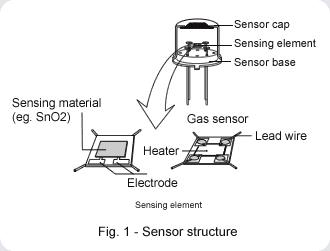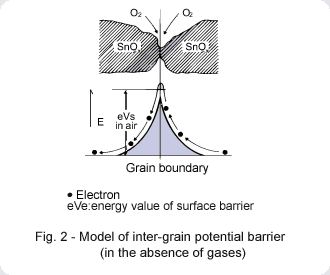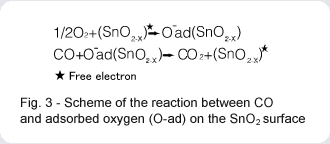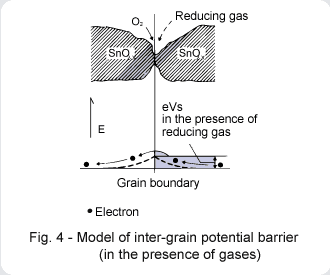This operating principle applies to all TGS8xx, TGS2xxx and TGS3xxx series sensors.
Fig. 1 shows basic gas sensor structure of TGS26xx series sensors as an example.
The gas sensor is composed of sensing element, sensor base and sensor cap. The sensing element contains sensing material and heater to heat up sensing element (eg. 400Åé). Depending on the target gas, the sensing element will utilize different materials such as Tin dioxide (SnO2), Tungsten oxide (WO3), etc.
When a metal oxide crystal such as SnO2 is heated at a certain high temperature in air, oxygen is adsorbed on the crystal surface with a negative charge. Then donor electrons in the crystal surface are transferred to the adsorbed oxygen, resulting in leaving positive charges in a space charge layer. Thus, surface potential is formed to serve as a potential barrier against electron flow (Figure 2).
Inside the sensor, electric current flows through the conjunction parts (grain boundary) of SnO2 micro crystals. At grain boundaries, adsorbed oxygen forms a potential barrier which prevents carriers from moving freely. The electrical resistance of the sensor is attributed to this potential barrier.
In the presence of a deoxidizing gas, the surface density of the negatively charged oxyge decreases, so the barrier height in the grain boundary is reduced (Figures 3 and 4). The reduced barrier height decreases sensor resistance.
The relationship between sensor resistance and the concentration of deoxidizing gas can be expressed by the following equation over a certain range of gas concentration:
Rs = A[C] -α
where: Rs = electrical resistance of the sensor
A = constant
[C] = gas concentration
α = slope of Rs curve
Due to the logarithmic relationship between sensor resistance and gas concentration, semiconductor type sensors have an advantage of high sensitivity to gas even at low gas concentration.
The excellent stability and performance of the semiconductor type sensor provides maintenance-free, long lived, and low cost gas detection.
Figaro provides various sensors which have different sensitivity characteristics by selecting the most suitable combinations of sensing material, temperature and activity of sensor materials. |
 |
 |
 |
 |
|



